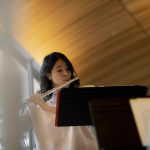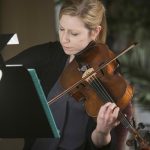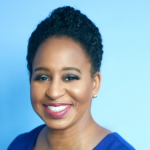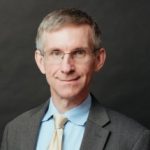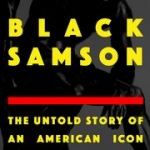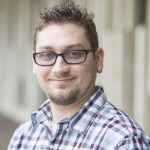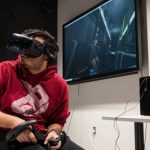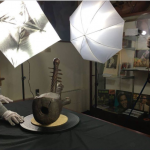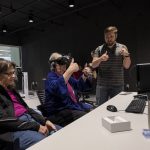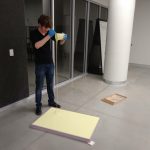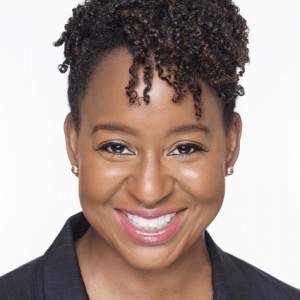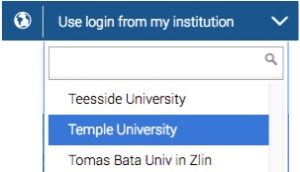What started out as part-time employment for erstwhile undergraduate student Michael Carroll has morphed into a fascinating career reviewing, organizing, and digitizing archival collections that move him back and forth through time and space, a medieval manuscript or a Renaissance Italian log of commercial transactions on one day,
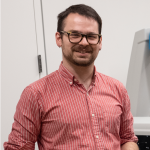
Michael Carroll
a montage of 20th century Philadelphia street scenes on another, and yet historical and stereotypical images of racial bias on another. Michael Carroll holds a B.A. (2014) and M.A. (2019) in Art History from Temple University and he is currently working on a Masters in Library Science from Clarion University. He began working in Paley Library (R.I.P., 1966-2019) as a sophomore and continued this part-time position after returning from a junior year abroad program in Italy. He was hired into a full-time position at Paley Library in 2016.
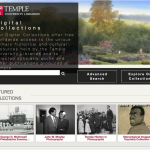
Temple Digital Collections
Michael currently leads a team of mostly student workers digitizing the amazing collections in the Charles Library Special Collections Research Center (SCRC) and the Charles L. Blockson Afro-American Collection. His work combines a close attention to detail and technical expertise with an art historian’s eye for the unusual, the ordinary, and the beautiful. For an overview of what he does in his work, listen to minutes 4:09 to 11:42 of the audio.
Humanities librarians Jill Luedke (Art & Architecture) and Rebecca Lloyd (History, Spanish/Portuguese, Latin American Studies) interview Michael Carroll (12/05/2019) in this first Behind the Scenes audio, a series that will highlight the
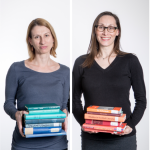
Rebecca Lloyd and Jill Luedke
unsung heroes of the Temple University Libraries. While students, faculty, alums, and community users generally only see the public-facing staff of the Library, there are many more people behind the scenes who organize and make available our vast physical and digital collections. In their positions Jill and Rebecca regularly depend on the materials Michael and his student workers digitize, so they were eager to learn more about his work. At the very end of the interview, Rebecca, Jill, and Michael talk about the importance of primary sources and the need for students and researchers to become more familiar with finding and interpreting them (33:20-38:09).
When asked about his favorite project, Michael explained that scanning and documenting Temple’s medieval manuscripts came out on top.

A Medieval Manuscript
Known officially as Bibliotheca Philadelphiensis, Temple’s contribution to this regional project consists of 43 scanned images, containing 15th century Italian business documents, choral sheet music, a book of hours, and a missal leaf.
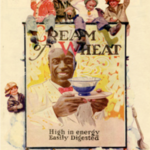
Stereotypical advertising image
Another special project that he worked on was the Stereotypical Images Collection, a collection of images, designed for classroom use, that represents racial and ethnic stereotypes in popular culture. (You can hear Michael talk about these projects between 16:24 and 18:47 of the audio.) One additional collection that Michael talks about is the work he did in collaboration with the SCRC and the Digital Scholarship Center (the current Duckworth Scholars Studio) scanning a vast
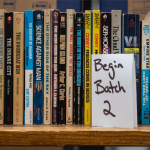
Science Fiction Books
science fiction collection with OCR technology in order to enable textual analysis and data mining of this digital corpus. He talks about this project during the interview when he discusses the technology-related aspects of his work (13:38 to 16:21).
Throughout the interview, Rebecca and Jill ask Michael to reflect on his career path and provide advice for students who might want to pursue their interests in the cultural sector as a
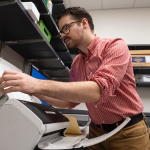
Michael Carroll, action photo
profession. He has very valuable and encouraging suggestions for anyone interested in this fascinating (and, as he cautions, often painstaking) line of work (18:48-21:46; 25:47-27:23; 29:01-32:08).
Since we recorded our original interview way back on December 5, 2019 — which at this point seems like a million years ago — we decided to check back in with Michael at his new pandemic workstation. In addition to providing some insight on how he overcame the initial disorientation and reorganized his work, it is also one among many testimonies to this strange and painful time we are living through.

